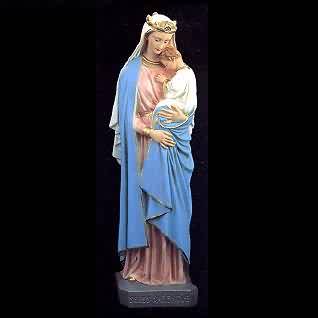Bridget
Forum All-Star


Joined: Feb 07 2005
Location: Michigan
Online Status: Offline
Posts: 2198
|
| Posted: Feb 02 2007 at 8:45pm | IP Logged
|
 |
|
This was on a website my Dh reads. Education Week
You have to register to read the article so I cut and pasted here.
Evaluating Montessori
Why the Results Matter More Than You Think
By Jacqueline Cossentino
The publication this past fall of research findings indicating significant performance gains for children who learn in Montessori schools has sent waves of interest throughout the educational community (Science, Sept. 29, 2006). Educators who care about ambitious school reform should take careful note.
Using a set of excellent proxies for learning—not just achievement—and equally impressive population and implementation controls, psychologists Angeline S. Lillard of the University of Virginia and Nicole M. Else-Quest, then of the University of Wisconsin, have produced, for the first time, scientific evidence that Montessori “works,” and not just for children of privilege. Drawing from a population of inner-city public Montessori school students, the study shows that 5-year-olds in the group outperformed their non-Montessori counterparts in nearly every measure. Findings for 12-year-olds, while not as dramatic, also suggest reliable success rates for Montessori students.
Even more important, the study offers clues to both why Montessori works and what it would take to make it work for large numbers of students. Yet while the study’s impeccable design and stunning results are what prompted the journal Science to accept it, critics continue to express doubt about both the reliability of the results (too small a sample) and the efficacy of Montessori as a successful approach to reform (no system can be that good).
Many of the elements of Montessori thought to be “quaint” and “unscientific” have been validated and absorbed into the educational mainstream.
In fact, the findings, along with the critiques, recall early reactions to Maria Montessori and the “miracle children” whose reading, writing, self-care, and concentration looked more like those of well-behaved adults than preschool-age children. They were the products of Montessori’s new method of educating the young, honed and developed at her first “Children’s House,” whose founding in Rome 100 years ago this month is being celebrated this year. When Montessori later brought the “method” to the United States, there was both awe and disbelief.
Lacking a thorough understanding of the complexities of Montessori’s approach, critics such as the noted Teachers College, Columbia University, professor William Heard Kilpatrick railed against the “fallacies” of self-correcting materials, “outworn and castoff” psychological theory, and a sharp focus on concentration at the supposed expense of social development.
A century later, contemporary psychology has caught up to Montessori’s revolutionary insights (insights gained from close and ongoing child study), and many of the elements of Montessori thought to be “quaint” and “unscientific” not only have been validated by experimental psychology, but also have been absorbed into the educational mainstream. It is now common, for instance, to find child-size furniture, manipulative materials, mixed-age grouping, and differentiated instruction in all manner of American classrooms.
Likewise, new research on brain development, embodied cognition, and motivation provides striking confirmation of Montessori’s claims regarding sensorial learning, attention, and intrinsic vs. extrinsic rewards. Still, the early criticisms were powerful and, for many Americans, compelling enough to discredit both the method and the movement.
Montessori’s early popularity soon faded, and the movement disappeared from the American educational scene. But by 1960, an “Americanized” Montessori approach reappeared, and this time it stuck. Spearheaded by a group of leaders who sought to integrate Montessori into the educational mainstream, Americanized Montessori emphasized social development, including social justice, and appealed directly to a new generation of middle-class, college-educated suburban mothers seeking “the best” for their preschool-age children.
Montessori schools and training centers proliferated throughout the 1960s, and, beginning in the 1970s, public Montessori schools were incorporated into several district desegregation plans. Milwaukee, the site of the Lillard and Else-Quest study, offers one of the oldest and most successful examples of the public magnet model of Montessori. For mainstream reformers, the details associated with the site are what give the most important clues to what is working for these schools and why.
Efforts to achieve ambitious reform—reform that substantially improves teaching and learning and, by extension, achievement—have, so far, yielded spotty and, at times, confounding results. This is especially true when reformers attempt to “scale up” or transport successful initiatives. New York City’s celebrated approach to continuous improvement, first orchestrated by Anthony J. Alvarado, then a community superintendent, yielded impressive results in the school system’s District 2. When the model traveled with Alvarado to San Diego, however, reformers found that good ideas, especially complex ones, don’t necessarily transplant with ease.
Seeking to crack the code of ambitious school reform, many researchers have turned their attention to two key variables: capacity and coherence. The new Montessori study offers important insight into both these phenomena, suggesting powerful lessons for reformers.
As researchers such as Harvard University’s Richard Elmore and his colleagues in the Consortium for Policy Research in Education have argued, building capacity takes deep and systemwide understanding of the core technologies of teaching and learning. In Montessori schools, this means deep knowledge of what Montessori is (and isn’t). And that knowledge comes first and foremost from the training centers that prepare teachers to work in these schools.
The how, why, and what of education must make sense in practical as well as theoretical ways.
Montessori teaching practice is among the most technically complex approaches to instruction ever invented. Doing it well requires teachers to have mastered both the details of developmental theory and the carefully orchestrated sequences and activities that make up the Montessori curriculum. Deploying this vast knowledge base is further supported by ongoing clinical observation, which forms the basis for all interactions with children.
In Milwaukee, public Montessori schools are supported by a rigorous training program that adheres to strict standards based on an interpretation of Montessori education that is both complex and stable. While in most schools the knowledge base for teaching is a moving target—contested, contingent, contextual—in most Montessori schools, and especially in the Milwaukee schools studied, that knowledge base has changed little in the hundred years since it was first developed by Maria Montessori. Critics may charge that such stability amounts to a “stale” or “dogmatic” approach to pedagogy, but the results suggest otherwise. These results should prompt us to look much more closely at the “what” as well as the “how” of capacity.
Coherent reform means improvement efforts that hang together in a systematic and consistent manner. The how, why, and what of education must make sense in practical as well as theoretical ways, which means that improvement plans cannot be grafted together in a random or piecemeal fashion. When the reform involves Montessori, achieving coherence takes leadership that appreciates both the complexity of the Montessori knowledge base and the totality of Montessori as a system.
Central to the Montessori system is a holistic view of the child and his or her participation in a complex world. That Montessori children read early or outperform their peers on standardized tests is, in fact, a byproduct of a system that seeks to make the most of natural developmental instincts in children. To emphasize the results, as impressive as they are, over the totality of the system is to miss the most important lesson Montessori has to offer the mainstream.
Montessori leaders must have both the knowledge and the will to do what it takes to ensure a full implementation of the approach. In theory, that means ensuring high-quality teacher preparation and properly prepared classroom environments. In practice—and in an age of high-stakes accountability—it means much more than that.
Ensuring full implementation means protecting the Montessori program from outside intrusion. It means establishing appropriate expectations among key constituents (parents, public officials, teachers). It means trusting the approach for what it is, as opposed to what it might be turned into. It means, perhaps most importantly, taking care not to view Montessori as a quick fix to the outcomes problem, the achievement gap, or any number of educational problems in need of solutions.
In this centenary year of Maria Montessori’s work, Angeline S. Lillard and Nicole M. Else-Quest have offered the education community a jewel, both in terms of the scientific quality of their study and the subject under investigation. Those of us who care about educational improvement on a larger scale should regard the many facets of this jewel with deliberateness and respect. As more studies follow, a new knowledge base for schooling can offer desperately needed insight into what successful reform can look like, and how to make it real.
Jacqueline Cossentino is an assistant professor of education policy and leadership at the University of Maryland, in College Park, Md. She is also the head of the Williamsburg (Va.) Montessori School, which serves as the primary site of her ongoing research on Montessori educational culture.
__________________
God Bless,
Bridget, happily married to Kevin, mom to 8 on earth and a small army in heaven
Our Magnum Opus
|


 Topic: Montessoti Article in Teacher Publication
Topic: Montessoti Article in Teacher Publication




